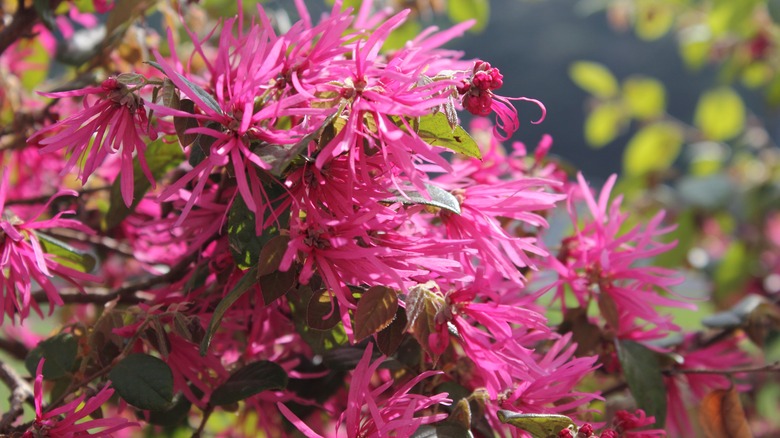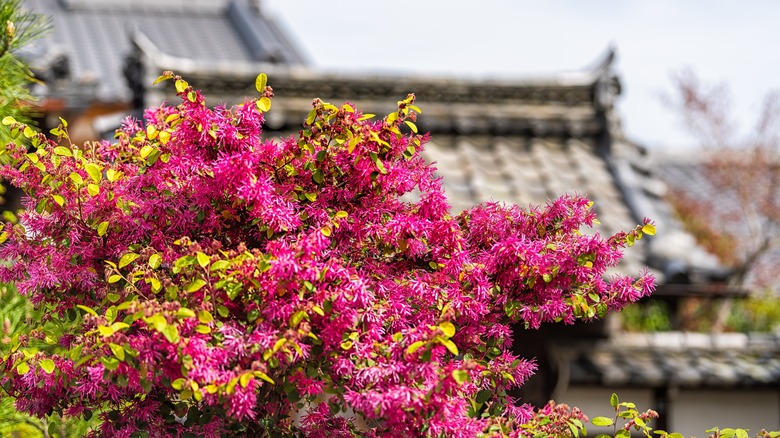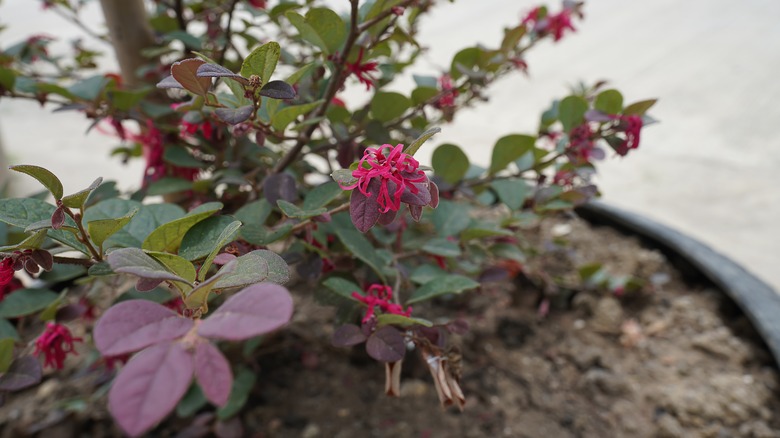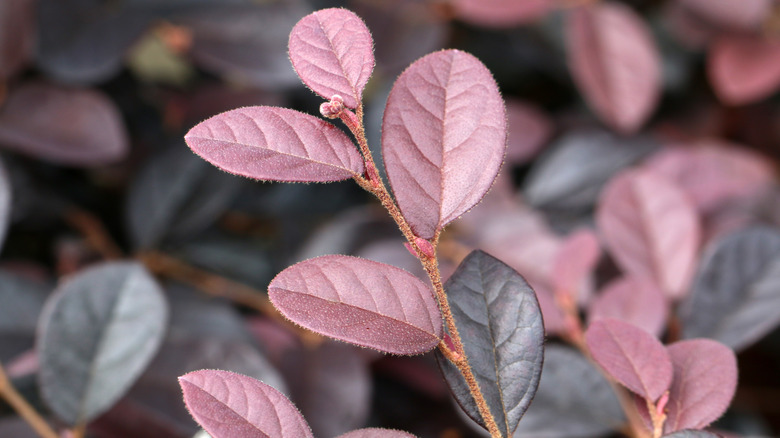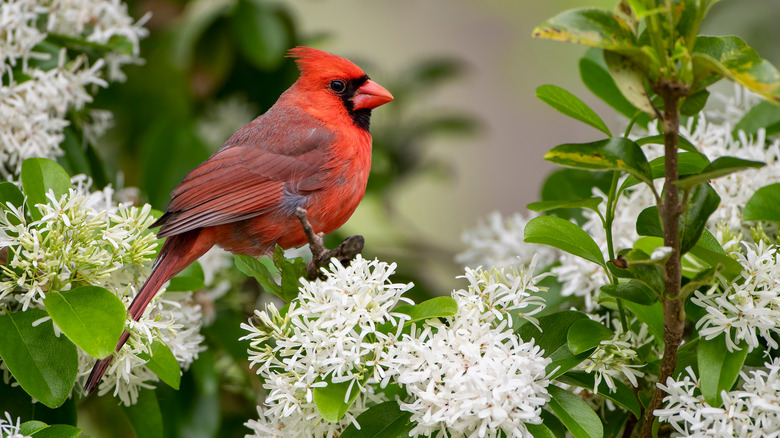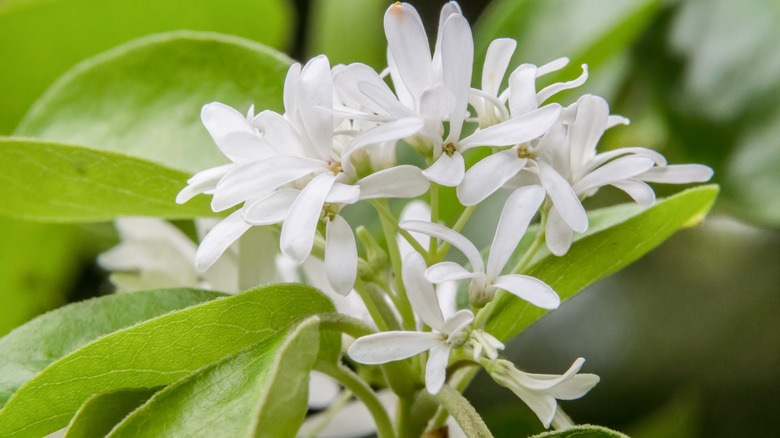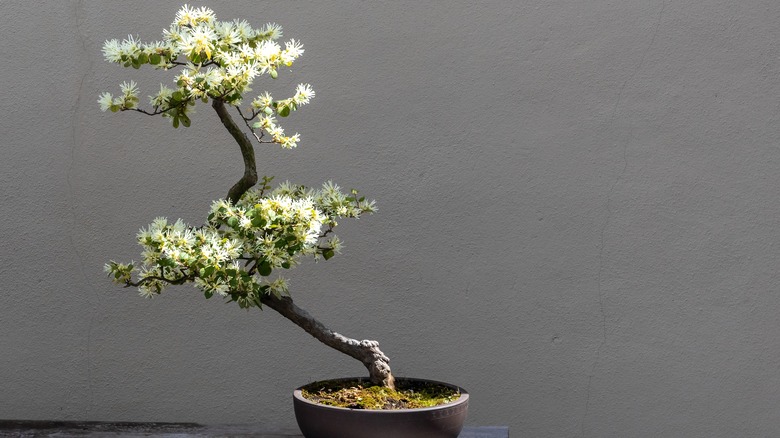How To Care For A Chinese Fringe Flower
Once a rarity in American gardens, the Chinese fringe flower (Loropetalum Chinense) has evolved into a popular choice for hedging, topiary, or as a dazzling individual plant. Native to the woodlands of China, the Himalayas, and Japan, this hardy evergreen shrub has been in the U.S. since 1880 but only achieved prominence 100 years later.
Related to the witch hazel family, the Chinese fringe flower typically ranges from 1 foot to 15 feet in height and can be 3 to 10 feet wide. However, according to Daily Gardener, it has even reached 35 feet in its native state (and has lived up to 100 years). Its flamboyant color scheme is one of its endearing features. The shrub is festooned with clusters of lightly scented, white, pink, red, or plum-colored flowers, atop hairy, oval-shaped leaves. It also will generate minuscule capsule-shaped fruits. The genus Loropetalum derives its name from the Greek words for strap and leaf, descriptive of the narrow flower petals of the Chinese fringe flower.
How to use Chinese fringe flower in garden
The fast-growing loropetalum can tolerate almost any type of ground, moisture, and light conditions. It is simple to grow, and requires minimal maintenance. Given its relative ease of growing and a wide range of styles, colors, and sizes, the Chinese fringe flower makes a welcome addition to any garden. The versatile plant offers both beauty and function.
The shrub's height makes it an obvious choice for shielding your property and ensuring privacy. The plant is also ideal for placing along a patio or porch, and Better Homes & Gardens suggests creating a border by integrating it with other easy-to-care-for shrubs. Blocking unsightly views or disguising a wall are typical uses for the fringe flower. Delineating one's property lines is another. Smaller or wider varieties are also suitable for erosion control on slopes or hillsides. The robust and eye-catching plant can fill a gap in any garden.
How to grow Chinese fringe flower
USDA hardiness zones 7 to 9 are considered by The Spruce to have optimal growing conditions for Chinese fringe flower. This plant will prosper in your garden, but it can be grown indoors as well. The Chinese fringe flower potentially has a 100-year lifespan in the wild, and can decorate your garden for at least 20 years. Optimal light conditions include full morning sun and light shade later in the day. Direct sun will stimulate flowering and enhanced color, and six full hours of sun is thought to be the benchmark. Moderate conditions are best, and plants should be grown in spring or fall to escape extreme temperatures. Frost and cold winter winds are harmful.
Loose and well-draining soil is recommended, augmented with rich organic matter such as compost. Clay soil is an acceptable alternative. Select a space with sufficient room for the plant to expand, instructs Plant Addicts. If growing from seeds, push them 1/2 inch below soil surface in a container, then water well. Plant the emerging seedlings when 4 to 6 inches long and surround with mulch. You can also propagate with cuttings derived from the mother plant, preferably in the summer.
How to care for Chinese fringe flower
Monitor the soil so your Chinese fringe flower does not get too dry or stay soaked between waterings. Don't water before evening in order to discourage evaporation. Guard against the soil becoming too alkaline, which will cause the plant's leaves to turn yellow. Malformed foliage and branches, and a paucity of blooms may also result. If necessary, add aluminum sulfate to increase soil's acidity. Garden Beast emphasizes that young plants require extra attention. Low winter temps can also cause discoloration, usually involving the external leaves. The damage from this so-called winter burn is generally superficial and temporary.
Chinese fringe flowers will withstand heavy pruning and pruned plants are capable of re-growing quickly. However, should you decide to cut back your plant, remove less than half of it at a time. The shrubs can be left au natural if you prefer. During the winter months, it is best to leave Chinese fringe flower be, with a minimum of pruning or fertilizing.
Chinese fringe flower varieties
There is a wide variety of Chinese fringe plants. However, according to expert Walter Reeves, there is some confusion regarding plant identities, cultivar names, patents, and trademarks. There are regular-sized cultivars as well as dwarves. Some have even been transformed into bonsai size. A full palette of flower and leaf colors is represented. Among the more popular types of the Chinese fringe plants, some featuring poetic names, are:
- Loropetalum Chinense Emerald Snowdance: This variety can grow up to 4 feet. White flowers adorn its green leaves.
- Loropetalum Chinense Carolina Moonlight: It generates white flowers intermittently after its initial early- to mid-spring bloom.
- Loropetalum Chinense Jazz Hands Variegated, aka Irodori: Multicolored foliage and bright pink flowers make this large cultivar a standout.
- Loropetalum Chinense Burgundy Bill Wallace: This plant will only grow to be a foot tall, but can attain 4 feet in width. A deep red coloration distinguishes this variety.
- Loropetalum Chinense Rubrum: This is another type that can be burgundy hued.
- Loropetalum Chinense Pizazz: This example is notable for its unusual purple plum color.
Is Chinese fringe flower toxic?
According to SFGate, toxic plant databases do not reference Loropetalum Chinense. Neither do the ASPCA nor FDA flag Chinese fringe flower as being poisonous to dogs, cats, horses, or children. Like its witch hazel cousins, the Chinese fringe flower contains tannins. Tannins are extremely bitter and serve to discourage animals and children from nibbling on the plants. Only a small amount is present in any case, so curious consumers are not likely to suffer ill effects.
A thriving Chinese fringe plant is likely to resist most pests or diseases. However, spider mites can take hold in a too dry or sun-baked plant, and aphids can also be an issue. Potential ailments to be on the lookout for in an unhealthy specimen include root rot and mildew. Bacterial gall, which are abnormal growths that can sap essential nutrients from the plant, may also occur. Anthracnose fungus, also known as blight, is another possible problem.
How to repot Chinese fringe flower
When preparing to repot Chinese fringe flower, first eyeball the root ball to estimate its size. Gently tickle out roots or even slash the root ball if plant is potbound. Fill its new container with soil and dig a hole up to three times the root ball's diameter, but a bit shallower. Place ball in hole and leave the top even with, or slightly above, the surrounding soil. Encircling the root ball with mulch is a good idea; it will help retain moisture and discourage weeds. Make sure there are no air pockets in the soil and water liberally. Until the plant takes hold, water once or twice a week. Thereafter, keep soil moist but not soggy.
According to Daily Gardener, Chinese fringe flowers should be repotted every other year. A repotted plant requires a minimum of fertilization; a slow-release, all-purpose fertilizer is appropriate for these shrubs, which thrive on high quantities of nitrogen, phosphorous, and potassium.
